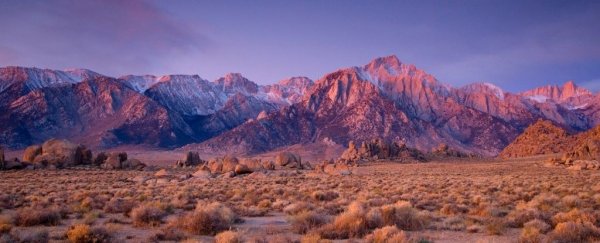The Sierra Nevada mountain range, which traces the eastern edge of California, has baffled geologists for years.
No one really knows when or how the crests and peaks of its silhouette first sprung into being, despite being one of the largest mountain belts in the world.
Some evidence suggests California's extensive mountain range is 'only' 3 to 5 million years old, while other evidence suggests it's more like 40 million years old.
That's a huge discrepancy, but what if those dates are both sort of right?
That might sound impossible, but new research from the giant basin to the southeast of the Sierra Nevada, which includes Death Valley, has now helped account for the mystery.
Exploring the volcanic, geologic, and tectonic history of this region, researchers think the Sierra Nevada might have two birthdays after all.
"There's been a lot of recent debate about when the Sierra Nevada came up as a mountain range, and our work is suggesting that both prevailing views are right – it's old and also young for completely different tectonic reasons," says geologist Lund Snee, who helped conduct the research while at Stanford University.
That's because the original Sierra Nevada seems to have 'died' between 20 and 40 million years ago, before being born again in a series of geological events that began around 10 million years ago.
The result is that the old Sierra Nevada – the one that began in central Nevada during the time of the dinosaurs – now lies in the shadow of its younger alter ego, which sits in California.
To the east of the Sierras lies the notorious depression known as Death Valley. Within it sits Titus Canyon, a formation that was once thought to have been created by run-off from the surrounding basin.
Ten years ago, a pair of geologists challenged those explanations, suggesting the layers of rock pointed to a different source for the sediments.
Further analysis by geologist Elizabeth Miller now backs up this 'bypass' explanation, finding the sediments must have been brought to Death Valley via "high energy" rivers and streams no earlier than 38 million years ago.
That means the sediment that collected at this low point must have been carried there from what was once a higher range of volcanoes, one that can be traced to sources further to the east, in what is today northern and central Nevada.
The findings suggest the US Continental Divide is perhaps not as static as we once assumed. Instead, Miller now suspects the Sierra Nevada has lived a turbulent life, with three completely different life histories.
The first life it lived began in central Nevada roughly 100 million years ago as a high range of volcanoes sloping down to the Pacific Ocean.
About 40 million years ago, researchers think this great divide began to migrate southeastward in a wave of volcanic activity. It was at this time that volcanoes in central Nevada began to spew so much lava downhill to the west, they created an even higher point in California, lifting the Earth in some places by more than a kilometer of magma.
This upward activity triggered a new set of rivers which then carried volcanic material from the east to the west, back to the ocean, which is what Miller has now found in Death Valley. These flows also carried lots of gold to California, which is what was found during the historic gold rush.
Once this younger Sierra Nevada range was uplifted, the authors say further tectonic activity chiseled out its various peaks and crests roughly 21 to 17 million years ago.
Not only do the new findings help explain conflicting dates on the origin of the Sierra Nevada, they also reveal important ways in which native plants and animals in California might have evolved with the changing landscape.
"You need to know when things happened and how long it took things to happen to truly understand them in the geologic context," says Miller.
"It's an evolving story, and as we pick up more pieces, the story begins to get tighter and tighter."
The new research is published in Tectonic Evolution of the Sevier-Laramide Hinterland, Thrust Belt, and Foreland, and Postorogenic Slab Rollback (180–20 Ma) for the Geological Society of America. You can read the research here and here.
